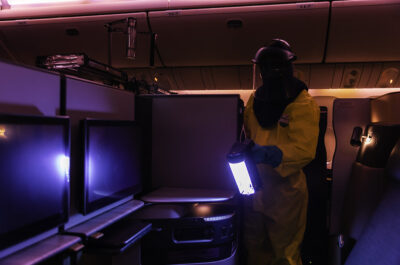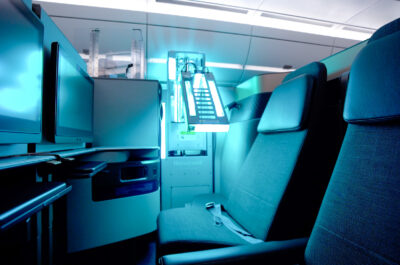Up to 9,250 deliveries of new business jets valued at over $250 billion expected through 2023; Operators plan to replace 28 percent of their fleets with new jets in the next five years.
LAS VEGAS – In its 22nd annual Business Aviation Outlook, Honeywell is forecasting up to 9,250 new business jet deliveries worth over $250 billion from 2013 to 2022.
The 2013 Honeywell outlook reflects an approximate 3 to 4 percent increase in projected delivery value over the 2012 forecast. Despite slightly lower unit deliveries, the expected value comes from pricing increases and a continued change in expected business jet delivery mix, which reflects the ongoing trend toward larger business jet models.
Honeywell forecasts 2013 deliveries of approximately 600 to 625 new business jets, a single-digit decrease over levels reported last year. The reduced deliveries expected in 2013 are largely due to new program delays rather than deterioration in demand.
“2014 industry deliveries are anticipated to be up modestly, reflecting recovery in supply- side constraints and some gains linked to the projected pace of global economic recovery,” said Rob Wilson, president, Honeywell Business and General Aviation.
Survey findings
In its latest survey, Honeywell found that the operators interviewed plan to make new jet purchases equivalent to about 28 percent of their fleets over the next five years either as a replacement or in addition to the their current fleet. This level of interest has been largely stable for the past four survey cycles, and compares favorably with results of 25 percent or less that were the norm until 2006. Of those new business jet purchase plans, 19 percent are intended to occur by 2014, with larger shares of more than 22 percent each year scheduled for 2015 and 2016 purchases. The survey does not allocate specific years beyond 2016. This is slightly improved from last year’s results and leads to a modest gain in projected demand in the near term.
Higher purchase expectations continue to focus on larger cabin aircraft classes ranging from supermidsize through the ultralong range and business liner, implying these types of aircraft will command the bulk of the value billed from now until 2023. This large cabin group is expected to account for more than 80 percent of all expenditures on new business jets in the near term. Volume growth between now and 2023 will be led by this class of aircraft, reflecting nearly 60 percent of additional units, and nearly 85 percent of additional retail value.
“The trend toward larger cabin aircraft with ever-increasing range expectations and advanced avionics is seen more strongly than ever in this year’s survey,” Wilson said. “As a full- spectrum supplier to the industry, Honeywell has been successful in anticipating the needs of and advancing the technological capabilities of the popular supermidsize and larger aircraft in production or scheduled to enter service over the next few years.”
“The Honeywell operator survey has been an invaluable tool for the industry over the past two decades,” explained Carl Esposito, vice president of Marketing and Product Management, Honeywell Aerospace. “The annual outlook has helped guide our own product decision process, which has led to focused investments such as designing and developing optimized propulsion offerings, flight efficiency upgrades, innovative safety products and enhanced services. It has also contributed to our business pursuit strategy, and helped position Honeywell consistently on high-value platforms in growth sectors.”
Regional buying details
Regional purchasing results are nuanced according to each market’s maturity, economic environment and other characteristics. Emerging markets generally show higher, but historically more volatile, levels of demand and a more pronounced preference for larger aircraft. As traditional regional markets have coped with economic variability and political uncertainties, key emerging markets have been shaping recent industry growth, backlog and portfolio composition.
This year we see a realignment of near-term regional market shares. The overall level of forecast aircraft demand coming from inside North America has increased for the first time in recent history. This year, roughly 61 percent of projected demand comes from North American operators, up eight points from the 2012 survey. “Stronger new aircraft acquisition plans in North America are welcome news and should support industry momentum as some of the higher growth regions work through a year of modestly reduced growth rates,” Wilson said.
Honeywell first began spotlighting growth in the BRIC countries (Brazil, Russia, India and China) in 2011. Last year, these results led the survey with 46 percent of respondents reporting acquisition plans. This has lowered to 42 percent in the 2013 survey, but with a strong near-term demand profile. Although last year about 40 percent of BRIC purchases were planned to happen within two years, this year 50 percent of intended purchasing activity is planned in the next two-year time frame.
Together, the emerging market results from BRIC countries reflect a slight tempering of enthusiasm compared with a year ago but are still quite strong when compared with other regions, or with results accrued during the more than 20 years Honeywell has been conducting the survey.
Asia Pacific
Operators in the Asia Pacific region, where many of the industry’s major players have high expectations for long-term future growth, report new jet acquisition plans equivalent to 24 percent of their fleet. This is lower than the 34 percent reported last year, and has slipped below the world average despite solid contributions from China. As a result, the total share of global demand over the next five years for Asia Pacific is about 5 percent, off two points from 2012 levels.
Fleets in this region have been growing at double-digit rates throughout the past five years. This year, just fewer than 20 percent of respondents plan new purchases within the first year of the five-year horizon. When comparing purchase timing in Asia Pacific between the past two surveys, it is evident that the front-loaded profile has leveled out and that part of the overall decline in purchase plans can be attributed to receipt of aircraft ordered in prior years, aligned with moderation of past exuberance and an economic tempering affecting the region’s major economies. However, this appears to be a short-term phenomenon as most forecasts call for a relatively strong recovery in economic growth within the region as soon as next year.
“It is critical to understand that survey findings from this part of the world remain based on a smaller base of operator pools and we do not believe the 2013 results represent any structural change in the region’s fundamental underlying growth drivers or commitment to business aviation,” Wilson noted.
Middle East and Africa
The share of projected five-year global demand attributed to the Middle East and Africa region moved toward the lower side of its historical 4-to-7 percent range this year.
In the Middle East and Africa, 26 percent of respondents’ fleets are projected to be replaced or added to with a new jet purchase, down from 32 percent last year. The level of purchase plans is near the world average even though 2013 has been a year of significant political upheaval and ongoing conflict in the region. Despite the regional distress, operators in the region indicate their purchases may happen sooner in the next five-year window than expected last year, with about 47 percent of purchases planned before 2016.
Latin America
Latin America’s survey results indicate 39 percent of the sample fleet will be replaced or added to with new jet purchases, which is unchanged versus last year’s result. Furthermore, planned acquisitions remain more front-loaded than the world average, with almost 52 percent of this region’s projected purchases timed to happen within the next three-year period. As with the Asia Pacific market, backfilling appears to have eased, albeit to a lesser extent. As a result of the high purchase plan levels, Latin America’s share of total projected demand held steady compared with a year ago at 18 percent.
North America
North America, the industry’s mainstay market, has seen new jet purchase plan levels improve – about three points – to the world average of 28 percent after averaging near 25 percent for the past six years. Though buying plan levels might be moderate when compared with emerging markets, North America represents more than half of projected global demand for the next five years based on the region’s historically dominant installed business jet base, affirming the region’s indisputable importance to the industry’s future.
Timing of North American acquisitions has been deferred compared with other regions, suggesting that despite improved aggregate five-year interest levels reported by potential purchasers, short-term conversion plans could be moderate until 2015–2016.
Europe
Europe’s purchase expectations declined this year, to 25 percent, and are below the 30 to 33 percent levels seen in the previous three surveys. The European share of estimated global five-year demand fell by six points to 12 percent in the 2013 survey. The resilience previously shown by European operators in the face of lackluster economic conditions may have reached the point of fatigue with weak growth prospects expected for 2014. Russia, which has supported the region with strong local purchasing ambitions, has slipped in reported purchase plans in the 2013 survey as well. We must note that Russian responses in this year’s survey were limited, so the small sample has added an element of volatility not present in prior surveys and may be understating the true demand for the region.
A comparison of the planned timing for European purchases indicates fairly even proportions of demand in the next three years of the five-year window, averaging about 20 percent per year.
“We continue to see underlying macro trends that support potential demand for business jets, making the industry’s long-term prospects attractive,” Wilson said. “Other factors we believe will help accelerate global business aviation growth are long overdue structural and regulatory reforms, which have the potential to unlock significant spending power that would propel aviation expansion. Product innovation in the form of Honeywell’s Ka-band satellite communication technology solutions and our SmartView Synthetic Vision System upgrades supports the expanded use of business aircraft as a key tool in the global economy.”
Flight activity
Shifting from jet purchases to flight activity, over the course of the past year the pace of recovery has been mixed. Much of the ground lost by operations during the 2009 recession still remains to be recaptured, but modest improvements in international flight activity and in U.S. operations in general have been seen in recent months.
Among the indices followed by Honeywell, pre-owned jets for sale and flight activity merit special attention.
The number of pre-owned jets for sale today has risen slightly from a year ago. Approximately 12.5 percent of today’s fleet is up for resale, down from a high of nearly 16 percent reached in 2009. Current levels are almost normal in light of the past decade’s history, but more reduction has been elusive recently despite declines in used aircraft asking prices.
Younger inventory (10 or fewer years old) usually makes up less than 20 percent of what is for sale, but this year its ranks still hovered around a quarter of all listings. This is down from record averages of about 30 percent reached in 2009. In 2013, improvements remain stalled, adding another cautionary note to overall market trends. On a positive note, respondents did increase their used jet acquisition plans moderately in this year’s survey by about six points, equating to 26 percent of their fleets in the next five years. All regions posted increased used jet buying plans except Africa and the Middle East.
Prospects for improved levels of flying activity in the near future are modest. Honeywell expects U.S. business jet cycles to close this year with a small expansion of about 1 to 2 percent, mostly attributed to international flight growth and by relatively strong charter operations. Next year should bring growth in the low single digits, presaging a slow, multiyear path back to historical normalcy.
European activity in 2013 – which does not include Russia in this case – is expected to decline approximately 3 percent. International flights (outside the EU) are actually positive thus far this year. Modest growth is expected in 2014, driven in part by improved economic prospects in Western Europe but also a stronger outlook for Eastern Europe. Within the survey, operator reported planned changes in business jet utilization were mixed with plans to fly more in North America and Africa and the Middle East contrasting with more neutral stances in other regions.
Fractional market
Flight activity for charter-like operations and fractional ownership appears to be doing relatively well in the U.S. but not translating into many new aircraft deliveries yet. Fractional operators have taken only 20 new jets this year. NetJet’s large order of 225 aircraft from Bombardier and Cessna last year boosted backlog figures, and additional orders including Directional Aviation’s 85 aircraft order this year should impact delivery performance favorably beginning in 2014 based on delivery schedules.
Tatiana is the news coordinator for TravelDailyNews Media Network (traveldailynews.gr, traveldailynews.com and traveldailynews.asia). Her role includes monitoring the hundreds of news sources of TravelDailyNews Media Network and skimming the most important according to our strategy.
She holds a Bachelor's degree in Communication & Mass Media from Panteion University of Political & Social Studies of Athens and she has been editor and editor-in-chief in various economic magazines and newspapers.













































































































































































